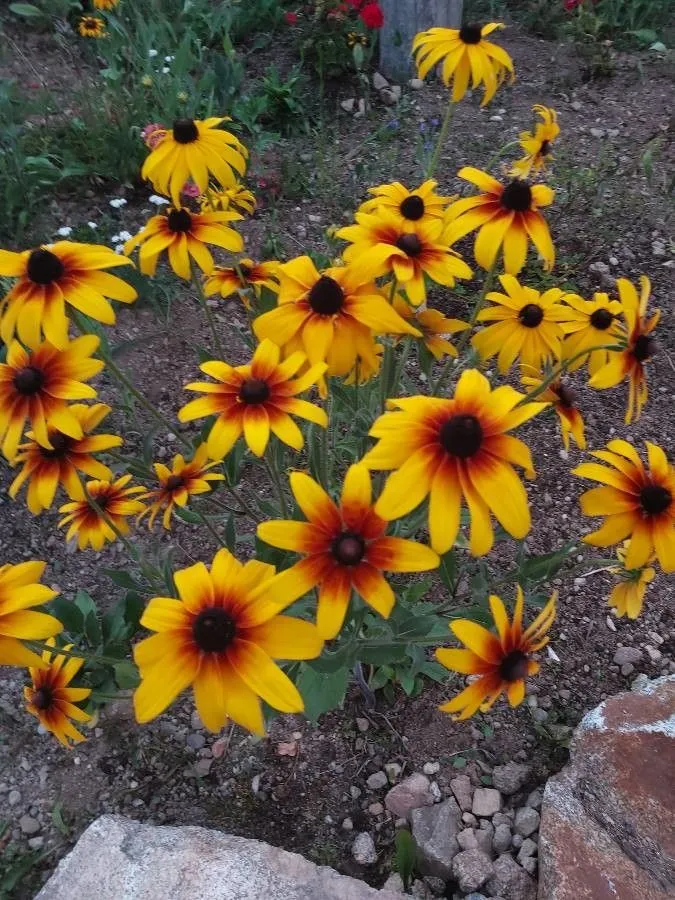
Author: Pursh
Bibliography: Fl. Amer. Sept. 2: 573 (1813)
Year: 1813
Status: accepted
Rank: species
Genus: Gaillardia
Vegetable: False
Observations: Subarctic America to N. U.S.A.
The Great blanket-flower, scientifically known as Gaillardia aristata, is a striking perennial that belongs to the family Asteraceae. First described by Pursh in 1813 in his publication “Flora Americae Septentrionalis”, this vibrant wildflower has captured the admiration of botanists and gardeners alike for over two centuries.
Hailing from subarctic regions of North America, extending down to the northern United States, the Great blanket-flower is well-adapted to a variety of climates. Its hardy nature allows it to thrive in diverse environments, from cool, subarctic territories to the more temperate zones of the contiguous U.S. This adaptability is one of the reasons it is a favorite among gardeners looking for low-maintenance, yet visually captivating, plants.
The plant is noted for its large, daisy-like blooms that can range in color from bright yellow to red and orange, often featuring a stunning, fire-wheel pattern with a distinctive darker center. These vivid flowers not only add a splash of color to any landscape but also attract various pollinators, including bees and butterflies, making it an excellent choice for those looking to support local ecosystems.
Gaillardia aristata prefers full sun and well-drained soil, which makes it particularly suited for rock gardens, borders, and mixed perennial beds. Due to its robust root system, it can tolerate drought conditions once established, further underscoring its resilience.
Overall, the Great blanket-flower is a versatile and hardy plant that offers both aesthetic and ecological benefits, ensuring its popularity in gardens and wildflower meadows across its native range.
Fra: gaillarde, gaillarde aristée
Deu: grannen-kokardenblume, prärie-kokardenblume
Eng: blanket-flower, common gaillardia, great blanket-flower, great blanketflower, brown-eyed susan, common blanketflower, gaillardia, great flowered gaillardia
Hun: évelő kokárdavirág
En: Great blanket-flower, Blanket-flower, Common gaillardia, Indian blanket flower, GAILLARDIA, Blanketflower, Common blanketflower, Great blanketflower, Brown-eyed Susan, Great flowered gaillardia
Ar: غيردية سفوية
Be: Гайлардыя асцюкаватая
Zh: 宿根天人菊
Cs: Kokarda osinatá
Et: Ohtene mõrsjalill
Fi: Syyssädekukka
Fr: Gaillarde, Gaillarde aristée
De: Prärie-Kokardenblume, Grannen-Kokardenblume, Kokardenblume
Hu: Évelő kokárdavirág
Lt: Akuotuotoji gailiardija
Mk: Обична кокарда
Fa: رعنای زیبای معمولی
Sk: Kokarda ostitá
Zh-tw: 宿根天人菊
Taken Jul 19, 2019 by Sabina Hartmann (cc-by-sa)
Taken May 31, 2020 by Dieter Albrecht (cc-by-sa)
Taken Dec 26, 2021 by llamas lucia (cc-by-sa)
Taken Jul 19, 2021 by susanne (cc-by-sa)
Taken Oct 10, 2021 by Ardien Van Der Kruit (cc-by-sa)
Taken Jun 27, 2021 by Dieter Albrecht (cc-by-sa)
Taken Dec 25, 2020 by Magalie Delalande (cc-by-sa)
Taken Jun 21, 2020 by Heiko D (cc-by-sa)
Taken Jul 19, 2019 by Sabina Hartmann (cc-by-sa)
Taken May 31, 2020 by Dieter Albrecht (cc-by-sa)
Taken Jun 12, 2021 by Ľubica Tellárova (cc-by-sa)
Taken Jul 18, 2022 by Kevin Keely (cc-by-sa)
Taken Dec 12, 2020 by Thibaut Valette (cc-by-sa)
Taken Jun 27, 2021 by Dieter Albrecht (cc-by-sa)
Taken May 31, 2020 by Dieter Albrecht (cc-by-sa)
Taken May 30, 2020 by Emilie Desgranges (cc-by-sa)
Taken Jun 27, 2021 by Dieter Albrecht (cc-by-sa)
Taken Sep 3, 2021 by Jacques Zuber (cc-by-sa)
Taken Jul 19, 2019 by Sabina Hartmann (cc-by-sa)
Taken Jul 21, 2019 by lisou lise (cc-by-sa)
Taken Sep 17, 2021 by Gerda Boenisch (cc-by-sa)
Taken Aug 5, 2020 by Mayumi (cc-by-sa)
Taken Dec 25, 2020 by Magalie Delalande (cc-by-sa)
Taken Sep 3, 2021 by Jacques Zuber (cc-by-sa)
Taken Nov 1, 2019 by Bergamini Giorgio (cc-by-sa)
Taken Jun 6, 2021 by Éric MARTINET (cc-by-sa)
Taken Jun 13, 2020 by petra lauria (cc-by-sa)
Taken Jul 9, 2022 by Mike Kos (cc-by-sa)
Taken Jan 2, 2017 by Yoan MARTIN (cc-by-sa)
Taken Sep 12, 2019 by Reiter franz (cc-by-sa)
© copyright of the Board of Trustees of the Royal Botanic Gardens, Kew.
© copyright of the Board of Trustees of the Royal Botanic Gardens, Kew.
© copyright of the Board of Trustees of the Royal Botanic Gardens, Kew.
Growth form>: Bunch
Growth habit>: Forb/herb
Growth rate>: Moderate
Ph maximum: 7.9
Ph minimum: 5.5
Family: Myrtaceae Author: (F.Muell.) K.D.Hill & L.A.S.Johnson Bibliography: Telopea 6: 402 (1995) Year: 1995 Status:…
Family: Rubiaceae Author: Pierre ex A.Froehner Bibliography: Notizbl. Bot. Gart. Berlin-Dahlem 1: 237 (1897) Year:…
Family: Sapindaceae Author: Koidz. Bibliography: J. Coll. Sci. Imp. Univ. Tokyo 32(1): 38 (1911) Year:…
Family: Asteraceae Author: A.Gray Bibliography: Pacif. Railr. Rep.: 107 (1857) Year: 1857 Status: accepted Rank:…
Family: Fabaceae Author: Medik. Bibliography: Vorles. Churpfälz. Phys.-Ökon. Ges. 2: 398 (1787) Year: 1787 Status:…
Family: Aspleniaceae Author: (Cav.) Alston Bibliography: Bull. Misc. Inform. Kew 1932: 309 (1932) Year: 1932…